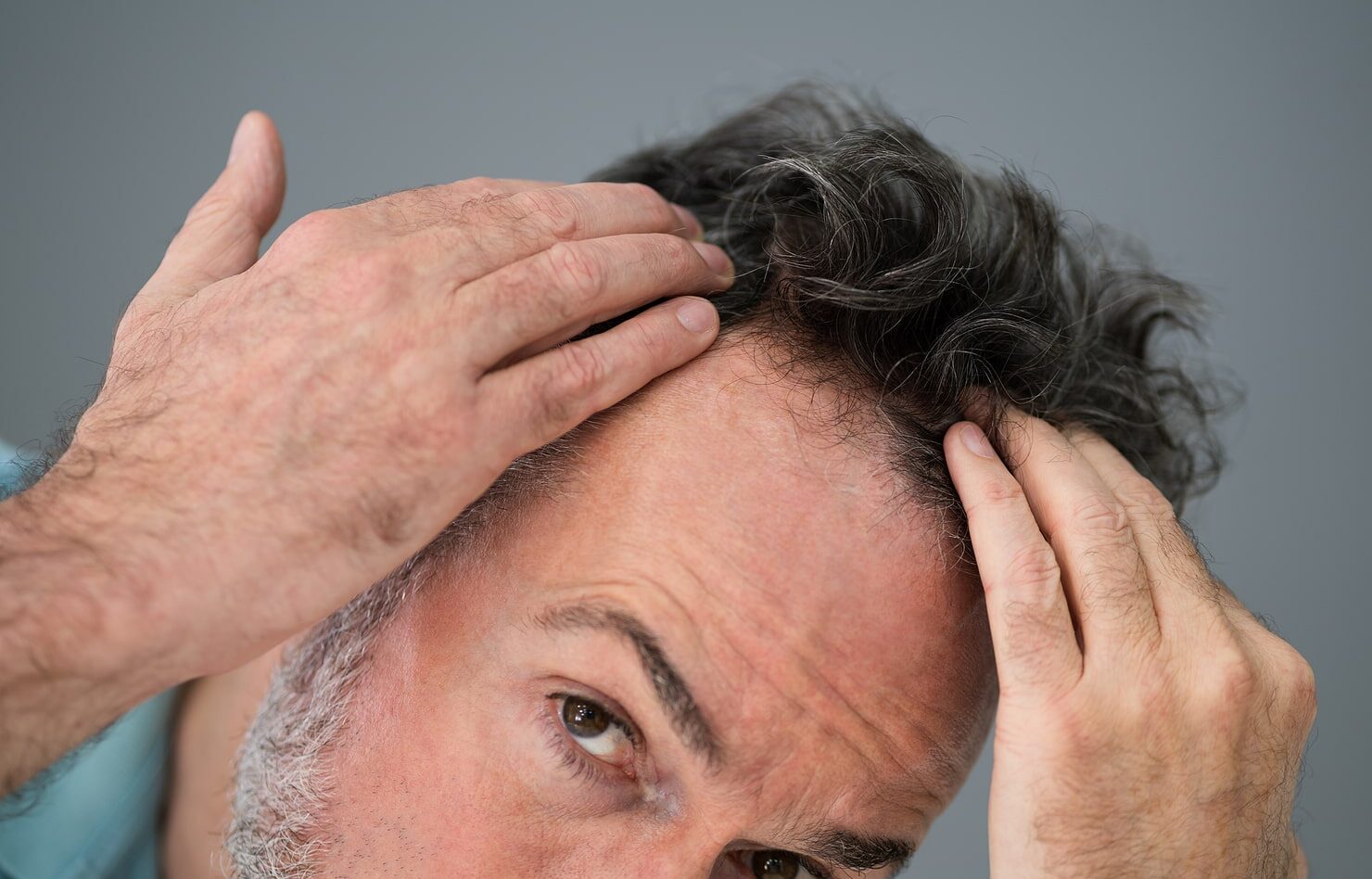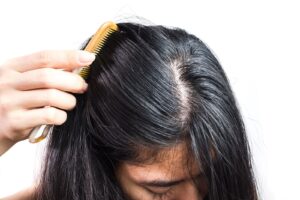Experiencing hair loss can be stressful and cause a decrease in confidence and happiness with your overall appearance. Fortunately, there are a number of hair loss solutions available. Read on for more on male pattern baldness, what causes it, and what you can do to address it.
What is Male Pattern Baldness?
Male pattern baldness, or androgenic alopecia, is the most common form of hair loss in men. It is defined by the loss of hair on the scalp as levels of certain hormones, such as testosterone and dihydrotestosterone (DHT), change over a man’s lifetime. According to the U.S. National Library of Medicine, over 50% of men over 50 will be affected by some level of male pattern baldness. By age 35, approximately 2/3 of men in the U.S. have experienced hair loss, and by age 50, 85% of men have.
Signs and Symptoms
Male pattern baldness usually first appears at the hairline or top of the head. It may progress to partial or complete baldness over time. If you notice the hair near the crown of your head starting to look thinner or fall out, this could indicate male pattern baldness. Diffuse thinning throughout the entire scalp is another common sign. If your hair begins to fall out when you are washing or combing it, you may be suffering from male pattern baldness and should reach out to a local hair restoration service.
Potential Causes
There are a variety of potential causes for male pattern baldness, including:
- Family history – If one or both of your parents have hair loss in their history, you may be more likely to experience it. One study, published by PLOS Genetics, found that there are at least 287 genetic variations associated with male pattern baldness.
- DHT production – DHT is an androgen that is produced in the body. It is a byproduct of testosterone, meaning the body naturally converts testosterone into DHT regularly. It is also the main hormone that is responsible for male pattern baldness because it binds to the follicles, causing them to weaken and shrink. Eventually, this slows hair growth and stops the follicle from producing new hairs. The longer your hair is exposed to DHT, the more likely you are to experience hair loss.
- Medications – Various medications can trigger hair loss. This includes antibiotics, which can deplete important hair growth vitamins and hemoglobin production. Vitamins, acne medications, immunosuppressants, blood pressure medications, and mood stabilizers have also been known to cause hair loss.
How to Address Male Pattern Baldness
Though it is a normal part of aging, it can be distressing for many men and may prompt them to look for a hair restoration solution. The following are common solutions for those experiencing male pattern baldness.
Laser Hair Rejuvenation
Laser hair rejuvenation is a non-invasive hair loss solution that uses low-level laser energy to treat balding areas of the scalp. Patients usually begin to see results after five or six treatments. This is an FDA approved process that is conducted by trained professionals to ensure safety. Laser light is absorbed by the scalp, which increases microcirculation and distributes a more abundant supply of blood flow and nutrients to the hair follicles. The laser light stimulates cellular activity in follicles in order to reduce hair loss and help regrow hair.
Laser hair therapy is a painless, manageable way to stimulate hair regrowth. It works to increase hair strength and density, resulting in fuller hair. Hair loss can cause a tremendous amount of anxiety and dissatisfaction with one’s appearance. Some people are ineligible for hair transplants for a number of reasons. Laser hair rejuvenation treatments are a great way to rebuild self-image without having to undergo an invasive procedure.
PRP
Platelet-rich plasma, or PRP, is a substance injected into the scalp to promote hair growth and prevent hair loss. A study published in 2014 by the Journal of Cutaneous and Aesthetic Surgery found that it is an effective method of treating male pattern baldness. Plasma is a component of the blood that contains proteins that help blood to clot and promote cell regrowth. PRP is used to treat damaged tissues throughout the body. A typical PRP procedure is conducted by a trained medical professional who will draw a blood sample from the scalp. The plasma is separated via a centrifuge. It is then injected into balding areas. Hair growth is usually noticeable after several weeks or months.
Hair Systems
A hair system is a hairpiece or partial wig made of human or synthetic hair. The membrane of a hair system resembles a layer of skin in that it is porous and transparent. Medical-grade adherent is applied by a trained hair replacement technician to bond the hair system to the surface of the skin. Hair systems are matched to your natural hair according to texture, density, and color. They are lightweight and comfortable to wear and require regular maintenance for longevity. Hair systems offer another non-surgical option for those experiencing male pattern baldness. They are instant and undetectable, making them ideal for those in need of quick results.
Wigs and Hairpieces
For those who are not interested in an invasive hair restoration procedure, a wig or hairpiece may be the best option. A hair restoration service can help you choose a high-quality wig and make sure it is styled properly and well maintained. You can work with a stylist to make sure your hairpiece looks as authentic as possible by choosing the right texture for your natural hair.
Both human hair wigs and synthetic wigs are available. They allow for the flexibility to change up your look as often as you would like. With regular upkeep and care, a wig can be a long-lasting hair loss solution that helps you regain confidence without having to undergo a procedure.
Hair Transplants
If you are interested in a more permanent solution, a hair transplant may be the right choice for male pattern baldness. A hair transplant is a medical procedure that involves taking hair follicles from another area on the scalp and implanting them where the hair loss has occurred. This means follicular units and strips of hair follicles are extracted and transplanted to balding areas. This is done via magnification and results in even, natural coverage.
Hair transplants must be conducted in-house by trained medical professionals in order to ensure a safe, effective procedure. Since transplanted hair works just like regular hair, no special treatments or chemicals are needed to maintain it. This is a cost-effective option in the long run that can save you on costs associated with other treatments and products that offer no real guarantee of hair restoration.
Contact Us
If you are looking for hair replacement or hair restoration services in Maryland or the Washington, D.C. area, contact Eldorado today. We offer a range of safe, hygienic, comprehensive hair loss solutions for male pattern baldness, delivered at our Baltimore, Maryland hair restoration clinic by medically trained technicians. Call us at (410) 931-3399 to discuss your hair restoration needs today.





